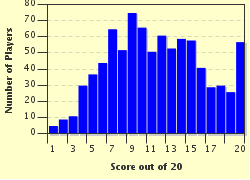Quiz Answer Key and Fun Facts
1. What was the operational name for the invasion of Normandy, France in 1944? (one word)
2. Perhaps the best kept secret of the war (which wasn't made public until the 1970s) was that the British had a code machine which, along with some brilliant code-breaking skills, allowed the Allies to read most of Germany's diplomatic code as well as some encrypted high-level military communication. The secret was known as Ultra. What was the name of the German encoding machine?
3. Operation Torch, in which my father participated, referred to which operation?
4. The invasion of Sicily by British and American troops in 1943 was known as Operation _______________.
5. Admiral Isoruku Yamamoto, who had planned the invasion of Pearl Harbor, was shot from the skies less than a year and a half later. The aerial interception was an ambush made possible by US intelligence, whose breaking of the Japanese Naval code and its exploitation was known as __________.
6. To keep the Germans guessing about Allied plans and unit strengths as preparations were made to invade Europe, an intricate deception plan was undertaken that involved fake radio traffic, inflatable tanks, and a host of other tricks. Gen. Patton, who the Germans believed to be the obvious choice to command the ground forces of the invasion, was even paraded about England to show that he was in command of the bogus force that had been created. This operation was ___________.
7. Hitler's invasion of the USSR in June 1941 was called ____________.
8. In its early stages, Operation Dragoon had been designated Operation Anvil. The former name was perhaps more appropriate, in that the real "hammer" was being swung north of its objective. Anvil, and later Dragoon, was the invasion of _______?
9. 15 June 1944: B-29 bombers dropped the first American ordnance on Japan since Doolittle's raid two years earlier. When the bombs were away, the codeword for success was sent out from the bomb group. It was_________?
10. When the A-bombs dropped on Japan in 1945, the US was engaged in planning for what would certainly be the costliest battle of the war (for both attacker and defender): the invasion of the Japanese home islands. When Japan capitulated after Hiroshima and Nagasaki, the invasion plan lost its raison d'etre. Operation _______, had it been necessary, would have killed millions upon millions, including US boys shipped in after having defeated Hitler.
11. What was the "Gooney Bird"?
12. Who or what was "Bouncing Betty"?
13. "Ike" was in command of Supreme Headquarters Allied Expeditionary Force. What acronym was used for this?
14. Operation Cobra referred to what?
15. Replacement Depots in the European Theater of Operations were known to troops as __________.
16. A drug used for "battle fatigue" cases at convalescent hospitals was thought to get combat soldiers over their fear of battle by causing them dream flashbacks to the front. However, their success rate was meager at best. These pills were known to troops as a variation of the name of one of the best weapons the Germans fielded in the war. What were they?
17. Churchill was fond of the idea of attacking the "soft underbelly" of Axis-controlled Europe. When this was undertaken, one American general-- seeing the bloody fighting in this country--instead found it "a tough old gut."
18. The first enemy ground troops faced by American soldiers outside the Pacific were referred to by this epithet.
19. The MF in REMF is an obscenity still in common use. What did the RE stand for?
20. A G.I. party referred to the following activity. Its use was still current when I was a cold-war soldier.
Source: Author
TwinFlame
This quiz was reviewed by FunTrivia editor
bloomsby before going online.
Any errors found in FunTrivia content are routinely corrected through our feedback system.

